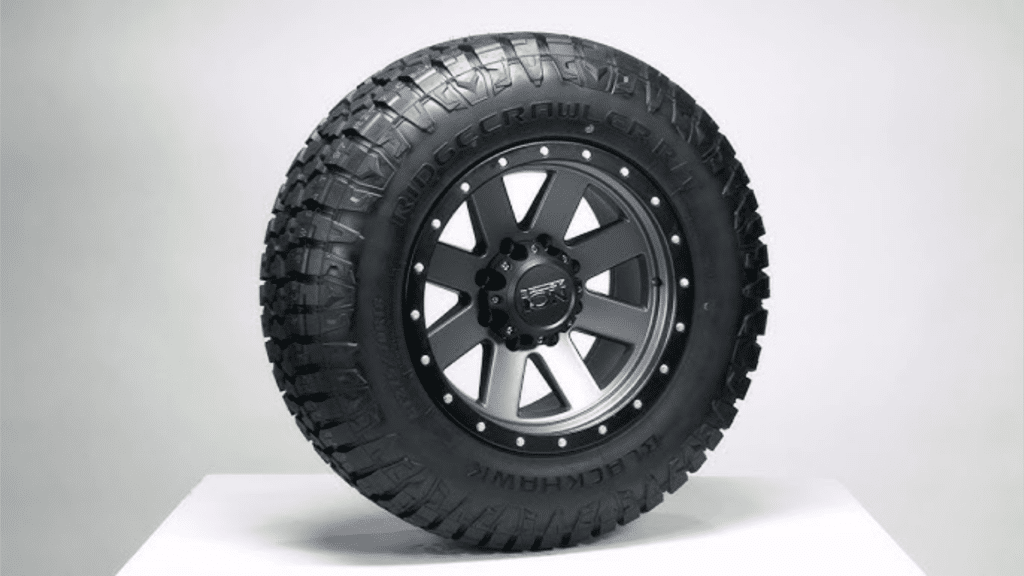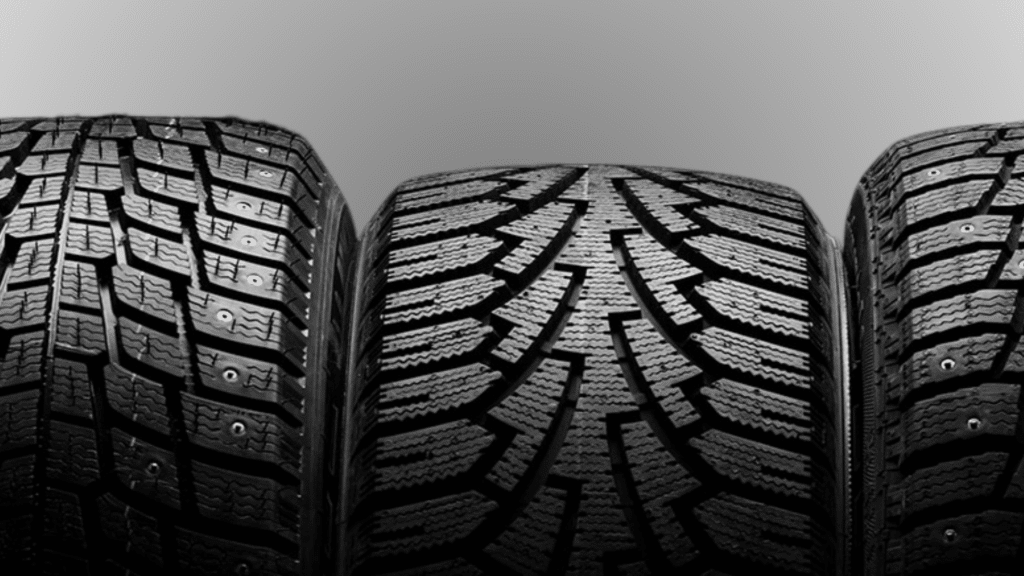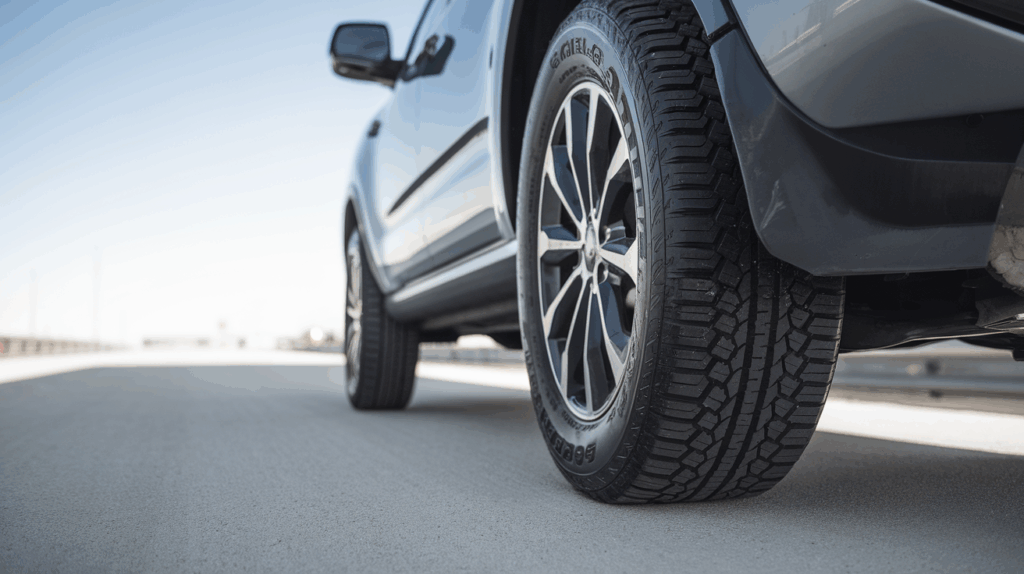When it comes to your vehicle’s safety and performance, tires make all the difference. Blackhawk tires have earned their spot in the market as a reliable choice for drivers who want quality without breaking the bank.
But with so many models and specs to choose from, finding the right Blackhawk tire can feel overwhelming.
That’s why I’ve created this complete guide. It doesn’t matter if you’re replacing worn-out tires or upgrading your current set; I’ll help you understand exactly what Blackhawk offers and which options work best for your vehicle.
I’ll walk through their different tire lines, explain what those confusing numbers on the sidewall mean, and share real maintenance tips to help your tires last longer.
By the end of this guide, you’ll have the knowledge to choose the right Blackhawk tires with confidence.
No confusing jargon or sales pitch – just clear, useful information to help you make a smart choice for your car.
Key Features of Blackhawk Tires

Innovative Tread Designs
I know choosing tires can be tricky, but Blackhawk’s tread patterns are designed with your safety in mind. Their signature zigzag grooves help push water away when you’re driving in the rain.
You’ll notice wide shoulder blocks – those chunky sections on the tire’s edges – that give you better control when turning.
The multi-wave sipes (those tiny slits in the tread) help your tires grip the road in both wet and dry conditions.
Durability and Material Quality
What makes Blackhawk tires tough? They use a special rubber compound that contains high-grade silica.
This means your tires won’t wear out quickly under normal driving. The sidewalls are reinforced with nylon caps, which help prevent bulging and damage from curbs.
You can expect about 50,000 miles from their touring models under normal driving conditions.
All-Weather Performance
How do these tires handle different weather? Here’s the breakdown:
- Summer driving: The hard center rib gives you stability at highway speeds
- Rainy conditions: Four wide grooves channel water out to prevent hydroplaning
- Light snow: The deep tread depth (typically 10/32 inches when new) helps you maintain traction
- Temperature changes: The rubber stays flexible between 20°F and 100°F
What I really like about Blackhawk tires is that they give you solid performance without the premium price tag.
While they might not match the absolute top-tier brands in extreme conditions, they’ll serve you well for daily driving in most weather conditions you’ll face.
Remember: Even the best tires need proper maintenance. Keep your tire pressure at the recommended level (usually between 32-35 PSI) and rotate them every 5,000 miles for the longest life.
Performance Review of Blackhawk Tires
On-Road and Off-Road Handling
I’ve analyzed how these tires perform in real-world conditions. On highways, Blackhawk tires provide stable steering response – you won’t feel that annoying wobble at high speeds.
The tires stay surprisingly quiet up to about 65 mph, though you might notice more road noise on rougher pavement. For city driving, they give decent feedback when you turn the wheel.
Off-road, their light truck models offer reasonable grip on gravel and packed dirt. However, be aware that in deep mud or loose sand, you’ll want to reduce your tire pressure to around 20 PSI for better traction.
The sidewalls are tough enough to handle occasional trail use, but these aren’t meant to be hardcore off-road tires.
Traction in Different Weather Conditions
When it comes to traction in different weather conditions, Blackhawk tires provide solid performance in a variety of environments.
However, their effectiveness varies depending on the road surface and weather conditions.
- Dry roads: Excellent grip and short braking distances, offering a safe and stable driving experience.
- Wet conditions: Good water evacuation, though you’ll want to reduce speed in heavy rain to avoid hydroplaning.
- Snow performance: Handles light snow and slush effectively, but deep snow requires the use of dedicated winter tires.
- Ice: Like most all-season tires, they have limited grip and are not ideal for icy conditions.
- Off-road: Provides reasonable grip on gravel and packed dirt, but not suitable for deep mud or loose sand without reducing tire pressure.
Longevity and Reliability
From what I’ve seen, Blackhawk tires typically last:
- Touring models: 45,000-55,000 miles with proper maintenance
- Light truck tires: 40,000-50,000 miles
- Performance models: 35,000-45,000 miles
The wear patterns are usually even, which tells me the internal construction is solid. Watch out for faster wear on the outer edges – that’s often a sign your alignment needs checking.
Most drivers report getting about 3-4 years of service before needing replacement, assuming regular rotation every 5,000 miles.
Keep in mind: Your driving style makes a big difference. Hard braking and aggressive cornering can cut tire life by up to 30%.
I’ve noticed these tires hold up best when you keep them properly inflated and avoid sudden maneuvers.
Advantages of Choosing Blackhawk Tires
Cost-Effectiveness and Value for Money
Let me share why these tires make financial sense. A set of Blackhawk tires typically costs 20-30% less than premium brands, but you’re still getting reliable performance.
From what I’ve seen, you’ll pay between $80-120 per tire for most passenger vehicles. The real value shows up in the cost per mile – with proper care, you’re looking at about 2-3 cents per mile, compared to 4-5 cents for premium brands.
Versatility Across Vehicle Types
What makes Blackhawk stand out is its range of options. Their tires fit:
- Compact cars and sedans (15-17 inch wheels)
- SUVs and crossovers (17-20 inch wheels)
- Light trucks and vans (16-18 inch wheels)
- Performance vehicles (17-19 inch wheels)
Each tire is load-rated appropriately for its intended vehicle. For example, their SUV tires can handle up to 2,000 pounds per tire – plenty for most family vehicles.
You’ll find compatible sizes for about 85% of passenger vehicles on the road today.
Eco-Friendly Manufacturing
I appreciate Blackhawk’s steps toward sustainability. Here’s what you’re supporting:
- Low rolling resistance designs that help reduce fuel consumption
- Recycled materials in the rubber compound where possible
- Manufacturing processes that use 30% less water than traditional methods
- Tread compounds that wear evenly, producing fewer particles
The tires are designed to minimize rolling resistance, which means your engine doesn’t have to work as hard.
You might notice a small improvement in fuel economy – typically about 1-2% compared to budget tires. While that might not sound like much, it adds up over the life of the tires.
Remember: These advantages work best when you match the right tire to your vehicle and driving needs.
What saves money for a daily commuter might not be the best choice for a weekend sports car.
Limitations of Blackhawk Tires
Challenges in Extreme Weather Conditions
Let me be straight with you about where these tires struggle. In temperatures below 20°F, the rubber compound gets noticeably stiffer, which means less grip. You’ll feel this most when:
- Taking corners in cold weather
- Braking on icy surfaces
- Driving through deep snow
The wet-weather performance has limits too. While fine in light rain, these tires don’t match premium brands when roads are flooded.
The tread patterns can handle about 2-3 inches of standing water before you risk hydroplaning.
Availability of Certain Models
Finding specific Blackhawk tires can be tricky. Here’s what I’ve noticed:
- Popular sizes often sell out at local dealers
- Some specialty sizes might need 2-3 weeks for delivery
- Winter tire options are limited in North American markets
- Performance tire models aren’t available in all regions
If you need an uncommon size or a specific model, you might have to check multiple dealers or wait for restocking. The distribution network isn’t as extensive as major brands like Michelin or Goodyear.
Price vs. High-End Competitors
While Blackhawk tires are budget-friendly, you do miss out on some premium features:
- Less sophisticated tread compounds for extreme performance
- Shorter tread life compared to top-tier brands
- Basic warranty coverage (typically 40,000 miles vs. 70,000+ for premium brands)
- Fewer technological innovations
The truth is, if you’re looking for maximum performance in challenging conditions or want the absolute longest-lasting tire, you might need to look at higher-priced options.
High-performance cars or heavy-duty trucks might benefit more from premium brands that offer specialized compounds and construction methods.
Remember: These limitations mainly matter if you drive in extreme conditions or need special performance features. For typical daily driving, Blackhawk tires still offer solid value.
Blackhawk Tires Compatibility with Different Vehicles
| Vehicle Type | Recommended Models | Size Range | Load Rating | Price Range (per tire) |
|---|---|---|---|---|
| Passenger Cars | ||||
| Compact Cars | BlackHawk HH01<br>BlackHawk Touring | 14″-16″ | 88-94<br>(1,235-1,477 lbs) | $65-85 |
| Sedans | BlackHawk HU02<br>BlackHawk Sport | 15″-17″ | 91-97<br>(1,356-1,609 lbs) | $80-110 |
| Family Cars | BlackHawk Elite<br>BlackHawk Comfort | 16″-18″ | 93-99<br>(1,433-1,709 lbs) | $90-130 |
| SUVs and Light Trucks | ||||
| Crossover SUVs | BlackHawk HT01<br>BlackHawk Cross | 17″-19″ | 102-106<br>(1,874-2,094 lbs) | $120-150 |
| Full-Size SUVs | BlackHawk Terra<br>BlackHawk AT Pro | 18″-20″ | 109-114<br>(2,271-2,601 lbs) | $140-180 |
| Light Trucks | BlackHawk AT3<br>BlackHawk HD | 16″-20″ | 116-121<br>(2,756-3,197 lbs) | $150-200 |
| Performance and Luxury | ||||
| Sport Sedans | BlackHawk UHP<br>BlackHawk Sport+ | 17″-19″ | 94-98<br>(1,477-1,653 lbs) | $130-170 |
| Luxury SUVs | BlackHawk Premier<br>BlackHawk Elite SUV | 19″-22″ | 107-111<br>(2,149-2,403 lbs) | $160-220 |
| Performance Cars | BlackHawk Max<br>BlackHawk Ultra | 18″-20″ | 93-97<br>(1,433-1,609 lbs) | $170-230 |
Key Notes:
- All prices are approximate and may vary by region
- Load ratings indicate the maximum weight capacity per tire
- Size availability may vary by specific vehicle model
- Always check your vehicle manual for exact specifications
- Special orders may be required for certain sizes
Comparing Blackhawk Tires to Competitors
| Brand Comparison | Blackhawk | Premium Brands | Mid-Range Brands |
|---|---|---|---|
| Average Price Point | |||
| Passenger Tires | $80-120 | $150-250 | $100-180 |
| SUV/Truck Tires | $130-200 | $200-350 | $160-250 |
| Performance Tires | $150-230 | $250-400 | $180-300 |
| Performance Metrics | Blackhawk | Premium Brands | Mid-Range Brands |
|---|---|---|---|
| Tread Life | 40-55K miles | 60-80K miles | 45-65K miles |
| Wet Handling | Good | Excellent | Very Good |
| Dry Handling | Very Good | Excellent | Very Good |
| Road Noise | Moderate | Low | Low-Moderate |
| Winter Performance | Fair | Very Good | Good |
| Customer Ratings (out of 5) | Blackhawk | Premium Brands | Mid-Range Brands |
|---|---|---|---|
| Overall Satisfaction | 3.8 | 4.5 | 4.1 |
| Value for Money | 4.2 | 3.7 | 3.9 |
| Durability | 3.7 | 4.6 | 4.0 |
| Comfort | 3.9 | 4.4 | 4.1 |
Key Insights:
- Blackhawk offers 35-40% savings compared to premium brands
- Warranty coverage: Blackhawk (40-50K miles) vs Premium (70-80K miles)
- Customer service response time: Blackhawk (48-72 hrs) vs Premium (24-48 hrs)
- Availability: Premium brands have wider distribution networks
Value Proposition:
- Best for: Daily drivers, budget-conscious buyers
- Not ideal for: High-performance vehicles, extreme weather conditions
- Sweet spot: Family cars and daily commuters in moderate climates
Remember: These comparisons reflect typical experiences and may vary based on specific models and driving conditions.
Tips for Maintaining and Maximizing the Life of Blackhawk Tires

Regular Tire Inspections and Maintenance
How to keep your Blackhawk tires in top shape? Start by checking your tires once a month – look for any unusual wear patterns or damage.
Run your hand along the tread (when the tires are cool) to feel for any bulges or cuts. Pay special attention to the sidewalls, where road damage often shows up first.
If you spot any cuts deeper than 1/4 inch, that’s a red flag needing immediate attention.
Use the penny test to check tread depth: insert a penny with Lincoln’s head upside down into the tread.
If you can see all of Lincoln’s head, your tread depth is below 2/32 inches, and it’s time for replacement. For Blackhawk tires, you’ll typically start with 10/32 inches of tread depth when new.
Proper Inflation and Rotation Practices
Getting tire pressure right makes a huge difference. Here’s my practical advice:
- Check pressure when tires are cold (parked for at least 3 hours)
- Keep the pressure at the level listed in your door jamb (usually 32-35 PSI)
- Don’t forget the spare tire – check it every few months
- Adjust pressure seasonally (add 2-3 PSI in winter)
For rotation, mark your calendar for every 5,000 miles. I’ve found that Blackhawk tires wear most evenly with this cross-rotation pattern:
- Front-wheel drive: Front to back, then cross the back tires to opposite front positions
- Rear-wheel drive: Back to front, then cross the front tires to opposite rear positions
- All-wheel drive: Cross-rotation for all tires
Storing Tires in Ideal Conditions
If you’re storing seasonal tires, proper storage makes a big difference in longevity. Keep them in a cool, dry place away from direct sunlight.
The ideal temperature range is 50-70°F. Stand them upright or hang them – never stack them flat. If you must lay them flat, don’t stack more than four high.
Before storing, clean them with mild soap and water, and make sure they’re completely dry. Consider using tire bags or covers to protect them from ozone damage.
Don’t store them near electric motors or other ozone-producing equipment – this can cause the rubber to age prematurely.
Remember: A little regular maintenance goes a long way. I’ve seen properly maintained Blackhawk tires last 20% longer than neglected ones. That’s like getting an extra season of use from your investment.
Conclusion
Understanding your tire choices should make life easier, not more complex. Throughout this guide, I have shown you how Blackhawk tires offer solid performance for everyday drivers without depleting your wallet.
Remember, the key to getting the most from your Blackhawk tires lies in proper maintenance – regular pressure checks, rotations, and keeping an eye on wear patterns.
You’re looking at good value, decent durability, and enough options to fit most vehicles on the road.
Ready to make a choice? Start by checking your vehicle’s tire size (it’s on your door jamb), then visit your local tire dealer.
They can help match you with the right Blackhawk model for your car and driving needs. Your wallet and your car will thank you.
Frequently Asked Questions
How Long Do Blackhawk Tires Really Last?
Under normal driving conditions and with proper maintenance, Blackhawk tires typically last 40,000 to 55,000 miles. Most drivers get about 3-4 years of use before needing replacement.
Remember that aggressive driving, rough roads, and extreme weather can reduce this lifespan by 20-30%.
What Makes Blackhawk Tires Different from Budget Brands?
While Blackhawk sits in the mid-range price category, they offer better build quality than typical budget tires.
The main differences are in their silica-enriched compounds, more sophisticated tread patterns, and stronger internal construction. You’ll notice better-wet grip and quieter operation compared to basic budget options.
Do Blackhawk Tires Work Well in Snow?
Blackhawk all-season tires handle light snow and occasional winter driving, but they’re not dedicated winter tires.
They perform adequately in temperatures down to about 20°F and can manage up to 2 inches of fresh snow. For heavy winter conditions or regular snow driving, you’ll want proper winter tires instead.
When Should I Replace My Blackhawk Tires?
Replace your tires when the tread depth reaches 2/32 inches (use the penny test), if you spot any bulges or cuts in the sidewall, or after 5-6 years regardless of mileage.
Don’t wait until you see the wear bars – that’s leaving it too late for safe driving.
Are Blackhawk Tires a Good Investment for My Car?
If you’re a daily driver who wants reliable performance without premium prices, Blackhawk tires offer good value.
They’re particularly worth considering if you drive mostly on paved roads in moderate weather conditions. However, if you own a high-performance vehicle or regularly drive in extreme conditions, you might want to invest in premium brands instead.

